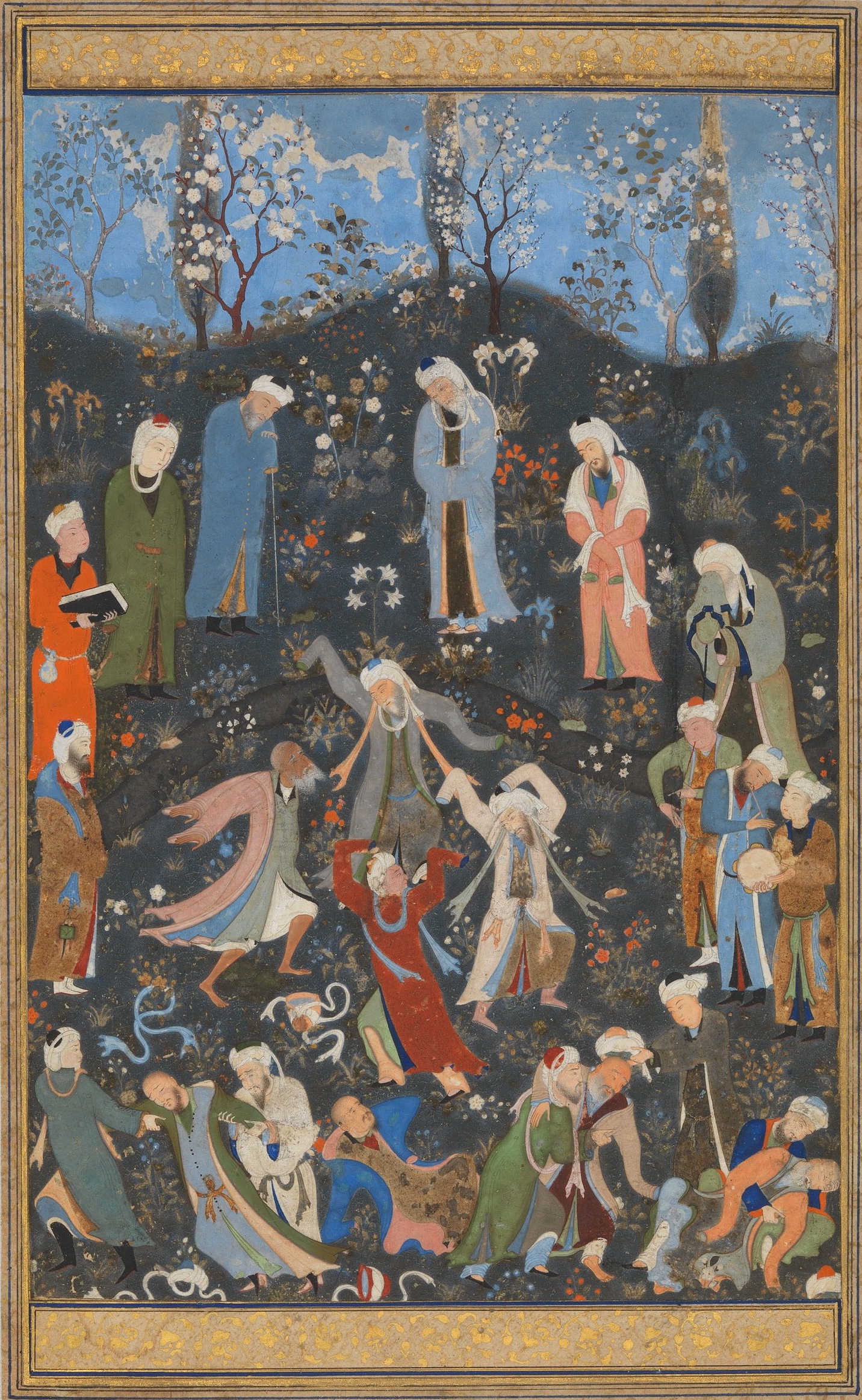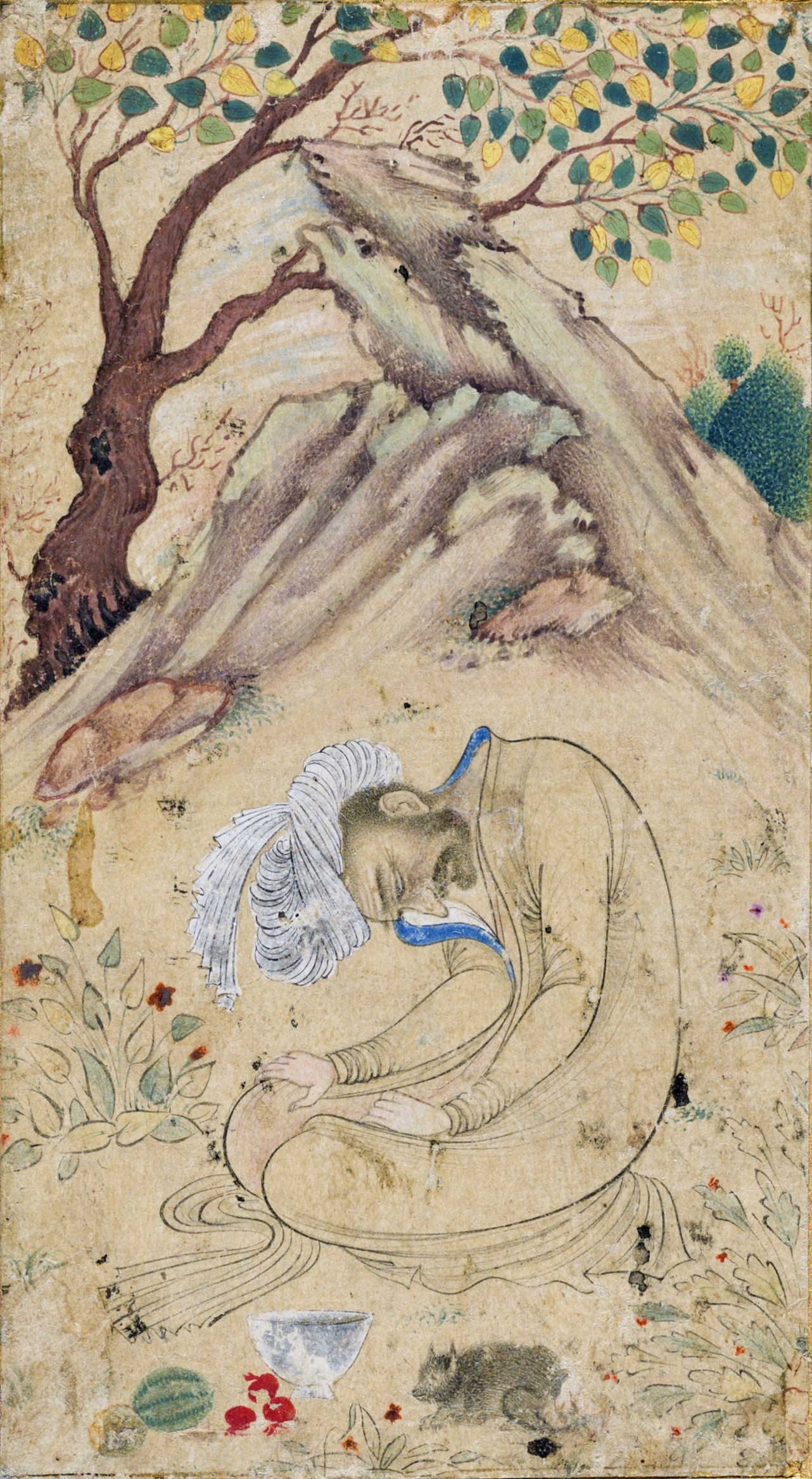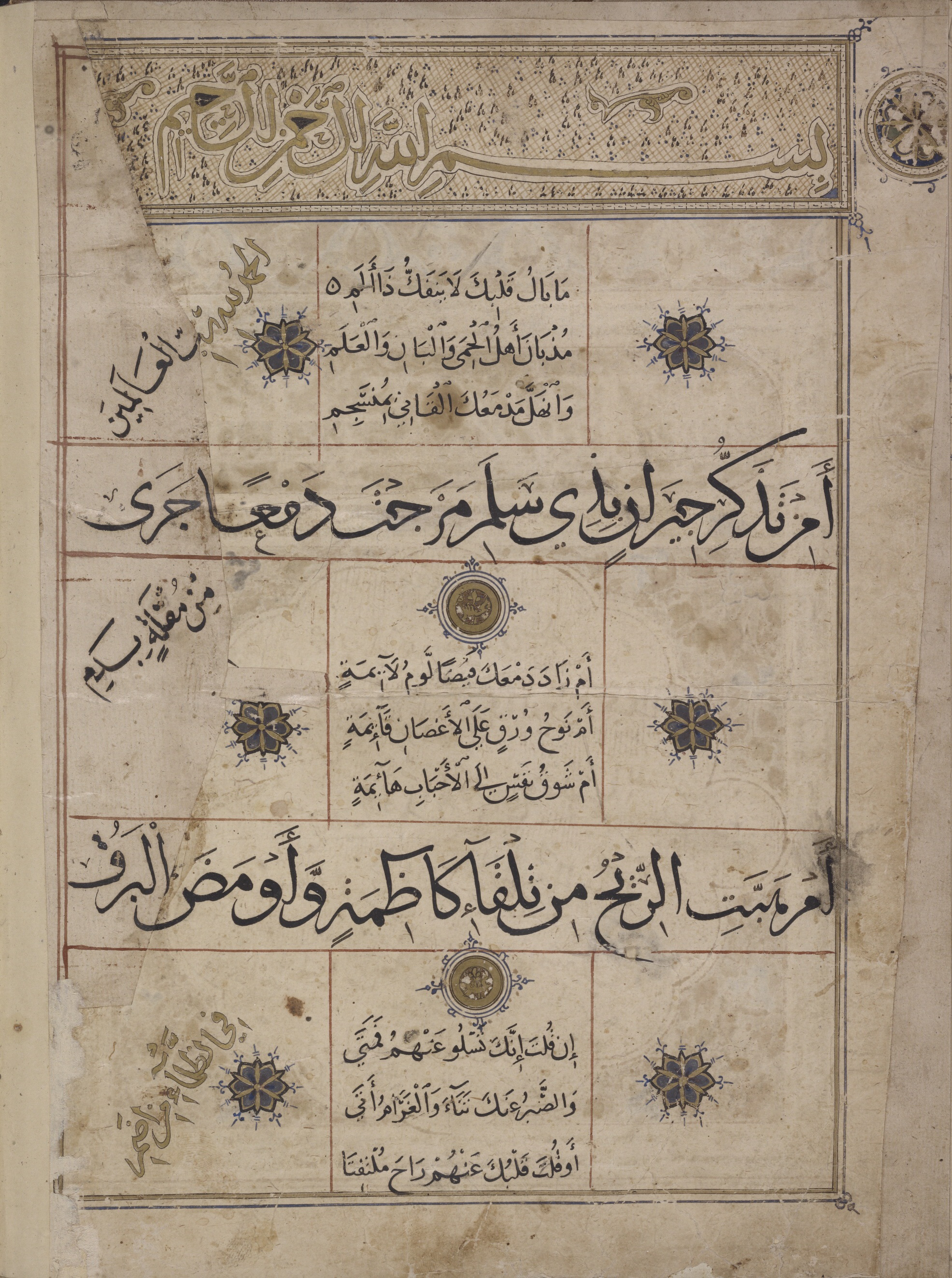|
Khawaja Muhammad Zaman Of Luari
Khawaja Muhammad Zaman of Luari (1713 - 1775 AD : 1125 - 1188 AH) ( sd, خواجہ محمد زمان لواري وارو) was a sufi saint and poet from Sindh. His father, Shaikh Abdul Latif Siddiqi, was a descendant of first Rashidun Caliph Abu Bakr. Their forefathers had moved to Sindh in Abbasid era. Biography Shaikh Abdul Latif was a follower of the Naqshbandi Sufi sect so Muhammad Zaman learned Quran and Sufi teachings from his father. Then he was sent to Thatta to study further in the Madrassa of Shaikh Muhammad Sadiq Naqshbandi who was a follower of Shah Abdul Latif Bhittai. During this time he met Khawaja Abul Masakin, who was a Sufi saint and a follower of the Sirhandi saints, and left the madrassa of Muhammad Sadiq Naqshbandi to start Sufi training under Abul Masakin from whom he later earned the title of Sultan Al Aoliya (Master of Sufis). After some time Abul Masakin appointed him his successor and himself went to Mecca for Hajj where he died shortly afterward. M ... [...More Info...] [...Related Items...] OR: [Wikipedia] [Google] [Baidu] |
Islam
Islam (; ar, ۘالِإسلَام, , ) is an Abrahamic religions, Abrahamic Monotheism#Islam, monotheistic religion centred primarily around the Quran, a religious text considered by Muslims to be the direct word of God in Islam, God (or ''Allah'') as it was revealed to Muhammad, the Muhammad in Islam, main and final Islamic prophet.Peters, F. E. 2009. "Allāh." In , edited by J. L. Esposito. Oxford: Oxford University Press. . (See alsoquick reference) "[T]he Muslims' understanding of Allāh is based...on the Qurʿān's public witness. Allāh is Unique, the Creator, Sovereign, and Judge of mankind. It is Allāh who directs the universe through his direct action on nature and who has guided human history through his prophets, Abraham, with whom he made his covenant, Moses/Moosa, Jesus/Eesa, and Muḥammad, through all of whom he founded his chosen communities, the 'Peoples of the Book.'" It is the Major religious groups, world's second-largest religion behind Christianity, w ... [...More Info...] [...Related Items...] OR: [Wikipedia] [Google] [Baidu] |
Sheikh (Sufism)
A Sheikh or shaykh (Arabic: شيخ shaykh; ; pl. شيوخ shuyūkh), of Sufism is a Sufi who is authorized to teach, initiate and guide aspiring dervishes in the Islamic faith. He distracts himself from worldly riches and women. The sheik is vital to the path of the novice Sufi, for the sheik has himself travelled the path of mysticism. Viewed as the spiritual master, the sheik forms a formal allegiance (''bay'a'') to the disciple of Sufism and authorizes the disciple's travels and helps the disciple along the mystical path. Islamic tradition focuses on the importance of chains and legitimization. In Sufism, sheiks are connected by a continuous spiritual chain (''isnad'', sanad, silsila). This chain links every previous Sufi sheik, and eventually can be traced back to the Successors, and in later times to the Prophet himself. As Sufism grew, influential shayks began to acquire spiritual centers and waypoints known as khanqah, ribat, and zaouia. Sheikhs duplicate the Prophetic ... [...More Info...] [...Related Items...] OR: [Wikipedia] [Google] [Baidu] |
Sindhi-language Poets
Sindhi ( ; , ) is an Indo-Aryan language spoken by about 30 million people in the Pakistani province of Sindh, where it has official status. It is also spoken by a further 1.7 million people in India, where it is a scheduled language, without any state-level official status. The main writing system is the Perso-Arabic script, which accounts for the majority of the Sindhi literature and is the only one currently used in Pakistan. In India, both the Perso-Arabic script and Devanagari are used. Sindhi has an attested history from the 10th century CE. Sindhi was one of the first languages of South Asia to encounter influence from Persian and Arabic following the Umayyad conquest in 712 CE. A substantial body of Sindhi literature developed during the Medieval period, the most famous of which is the religious and mystic poetry of Shah Abdul Latif Bhittai from the 18th century. Modern Sindhi was promoted under British rule beginning in 1843, which led to the current status of the la ... [...More Info...] [...Related Items...] OR: [Wikipedia] [Google] [Baidu] |
Sufis Of Sindh
Sufism ( ar, ''aṣ-ṣūfiyya''), also known as Tasawwuf ( ''at-taṣawwuf''), is a mystic body of religious practice, found mainly within Sunni Islam but also within Shia Islam, which is characterized by a focus on Islamic spirituality, ritualism, asceticism and esotericism. It has been variously defined as "Islamic mysticism",Martin Lings, ''What is Sufism?'' (Lahore: Suhail Academy, 2005; first imp. 1983, second imp. 1999), p.15 "the mystical expression of Islamic faith", "the inward dimension of Islam", "the phenomenon of mysticism within Islam", the "main manifestation and the most important and central crystallization" of mystical practice in Islam, and "the interiorization and intensification of Islamic faith and practice". Practitioners of Sufism are referred to as "Sufis" (from , ), and historically typically belonged to "orders" known as (pl. ) – congregations formed around a grand who would be the last in a chain of successive teachers linking back to Muhamm ... [...More Info...] [...Related Items...] OR: [Wikipedia] [Google] [Baidu] |
Sufi Poets
Sufism ( ar, ''aṣ-ṣūfiyya''), also known as Tasawwuf ( ''at-taṣawwuf''), is a mystic body of religious practice, found mainly within Sunni Islam but also within Shia Islam, which is characterized by a focus on Islamic spirituality, ritualism, asceticism and esotericism. It has been variously defined as "Islamic mysticism",Martin Lings, ''What is Sufism?'' (Lahore: Suhail Academy, 2005; first imp. 1983, second imp. 1999), p.15 "the mystical expression of Islamic faith", "the inward dimension of Islam", "the phenomenon of mysticism within Islam", the "main manifestation and the most important and central crystallization" of mystical practice in Islam, and "the interiorization and intensification of Islamic faith and practice". Practitioners of Sufism are referred to as "Sufis" (from , ), and historically typically belonged to "orders" known as (pl. ) – congregations formed around a grand who would be the last in a chain of successive teachers linking back to Muh ... [...More Info...] [...Related Items...] OR: [Wikipedia] [Google] [Baidu] |
Sindhi People
Sindhis ( sd, سنڌي Perso-Arabic: सिन्धी Devanagari; ) are an Indo-Aryan ethnic group who speak the Sindhi language and are native to the province of Sindh in Pakistan. After the partition of British Indian empire in 1947, many Sindhi Hindus and Sindhi Sikhs migrated to the newly independent Dominion of India and other parts of the world. Pakistani Sindhis are predominantly Muslim with a smaller Sikh and Hindu minority, whereas Indian Sindhis are predominantly Hindu with a Sikh, Jain and Muslim minority. Sindhi people have been native to Sindh throughout history, apart from that their historical region has always came from the South-eastern side of Balochistan, the Bahawalpur region of Punjab and the Kutch region of Gujarat, India. The Sindhi diaspora is growing around the world, especially in the Middle East, owing to better employment opportunities. Etymology The name Sindhi is derived from the Sanskrit ''Sindhu'' which translates as river or seabod ... [...More Info...] [...Related Items...] OR: [Wikipedia] [Google] [Baidu] |
Sufism
Sufism ( ar, ''aṣ-ṣūfiyya''), also known as Tasawwuf ( ''at-taṣawwuf''), is a mystic body of religious practice, found mainly within Sunni Islam but also within Shia Islam, which is characterized by a focus on Islamic spirituality, ritualism, asceticism and esotericism. It has been variously defined as "Islamic mysticism",Martin Lings, ''What is Sufism?'' (Lahore: Suhail Academy, 2005; first imp. 1983, second imp. 1999), p.15 "the mystical expression of Islamic faith", "the inward dimension of Islam", "the phenomenon of mysticism within Islam", the "main manifestation and the most important and central crystallization" of mystical practice in Islam, and "the interiorization and intensification of Islamic faith and practice". Practitioners of Sufism are referred to as "Sufis" (from , ), and historically typically belonged to "orders" known as (pl. ) – congregations formed around a grand who would be the last in a chain of successive teachers linking back to Muham ... [...More Info...] [...Related Items...] OR: [Wikipedia] [Google] [Baidu] |
Sufism In Sindh
Sufism in Sindh covers the tradition of Sufism in Sindh, which is reputed to be an area of mystics. Sindh is famous for the enormous number of saints and mystics who lived there and preached peace and brotherhood.Naz, H., D.R. (2015). Significance of the Malfuz Literature as an Alternative Source of History: A Critical Study on the Tadhkirat Al-Murad as the Earliest Malfuz Compiled in Sindh. Pakistan Historical Society. Journal of the Pakistan Historical Society, 63(2), 83-99. According to popular legend, 125,000 of them are buried on Makli Hill near Thatta.Lal, Mohan. Encyclopaedia of Indian Literature: sasay to zorgot'. Vol. 5. Sahitya Akademi, 1992. There is an abundance of Sufi literature produced in Sindh throughout history. History According to some scholars the original torch-bearer of Sufism in Sindh was the 13th century saint Usman Marwandi, also known as Lal Shahbaz. These scholars believe that Sufism arrived in Sindh via Herat, Qandhar and Multan. Sufism ... [...More Info...] [...Related Items...] OR: [Wikipedia] [Google] [Baidu] |
Mansoor Al Hallaj
Al-Hallaj ( ar, ابو المغيث الحسين بن منصور الحلاج, Abū 'l-Muġīth Al-Ḥusayn bin Manṣūr al-Ḥallāj) or Mansour Hallaj ( fa, منصور حلاج, Mansūr-e Hallāj) ( 26 March 922) ( Hijri 309 AH) was a Persian mystic, poet, and teacher of Sufism.Jawid Mojaddedi, "ḤALLĀJ, ABU'L-MOḠIṮ ḤOSAYN b. Manṣur b. Maḥammā Bayżāwi" i''Encyclopedia Iranica''/ref> He is best known for his saying: "I am the Truth" (Ana'l-Ḥaqq), which many saw as a claim to divinity, while others interpreted it as an instance of annihilation of the ego, allowing God to speak through him. Al-Hallaj gained a wide following as a preacher before he became implicated in power struggles of the Abbasid court and was executed after a long period of confinement on religious and political charges. Although most of his Sufi contemporaries disapproved of his actions, Hallaj later became a major figure in the Sufi tradition. Life Early years Al-Hallaj was born ar ... [...More Info...] [...Related Items...] OR: [Wikipedia] [Google] [Baidu] |
Sufi Metaphysics
In Islamic philosophy, Sufi metaphysics is centered on the concept of ar, وحدة, waḥdah, unity, label=none or ar, توحيد, tawhid, label=none. Two main Sufi philosophies prevail on this topic. literally means "the Unity of Existence" or "the Unity of Being." , meaning "existence" or "presence", here refers to God. On the other hand, , meaning "Apparentism" or "Monotheism of Witness", holds that God and his creation are entirely separate. Some scholars have claimed that the difference between the two philosophies differ only in semantics and that the entire debate is merely a collection of "verbal controversies" which have come about because of ambiguous language. However, the concept of the relationship between God and the universe is still actively debated both among Sufis and between Sufis and non-Sufi Muslims. Waḥdat al-Wujūd (unity of existence) The mystical thinker and theologian Abu Saeed Mubarak Makhzoomi discussed this concept in his book called ''Tohfa ... [...More Info...] [...Related Items...] OR: [Wikipedia] [Google] [Baidu] |
Sufi Poet
Sufi literature consists of works in various languages that express and advocate the ideas of Sufism. Sufism had an important influence on medieval literature, especially poetry, that was written in Arabic, Persian, Turkic and Urdu. Sufi doctrines and organizations provided more freedom to literature than did the court poetry of the period. The Sufis borrowed elements of folklore in their literature. The works of Nizami, Nava'i, Hafez, Sam'ani and Jami were more or less related to Sufism. The verse of such Sufi poets as Sanai (died c. 1140), Attar (born c. 1119), and Rumi (died 1273) protested against oppression with an emphasis on divine justice and criticized evil rulers, religious fanaticism and the greed and hypocrisy of the orthodox Muslim clergy. The poetic forms used by these writers were similar to the folk song, parable and fairy tale. Background Sufi literature written in Persian flourished from the 12th to 15th centuries. Later major poets linked with the Sufi tra ... [...More Info...] [...Related Items...] OR: [Wikipedia] [Google] [Baidu] |
Anno Hegirae
The Hijri year ( ar, سَنة هِجْريّة) or era ( ''at-taqwīm al-hijrī'') is the era used in the Islamic lunar calendar. It begins its count from the Islamic New Year in which Muhammad and his followers migrated from Mecca to Yathrib (now Medina). This event, known as the Hijrah, is commemorated in Islam for its role in the founding of the first Muslim community (''ummah''). In the West, this era is most commonly denoted as AH ( la, Anno Hegirae , 'in the year of the Hijra') in parallel with the Christian (AD), Common (CE) and Jewish eras (AM) and can similarly be placed before or after the date. In predominantly Muslim countries, it is also commonly abbreviated H ("Hijra") from its Arabic abbreviation '' hāʾ'' (). Years prior to AH 1 are reckoned in English as BH ("Before the Hijrah"), which should follow the date. A year in the Islamic lunar calendar consists of twelve lunar months and has only 354 or 355 days in its year. Consequently its New Year's Day occurs ... [...More Info...] [...Related Items...] OR: [Wikipedia] [Google] [Baidu] |
.jpg)






